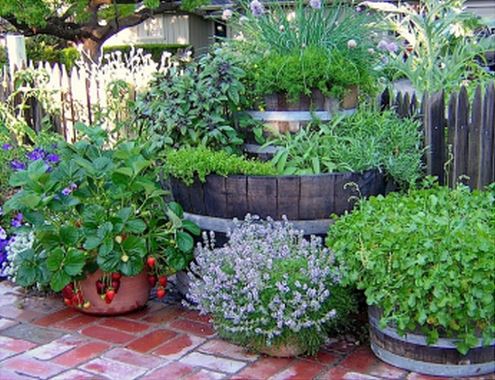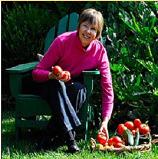Alden Lane Nursery - 981 Alden Lane - Livermore, CA 94550 - (925) 447-0280 ph - (925) 443-8512 fax
Spring & Summer Hours: Open 8:30 am - 6:00 pm Daily
Spring & Summer Hours: Open 8:30 am - 6:00 pm Daily

When in Drought, Plant More Vegetables Than Ever
Rosalind Creasy spoke here at Alden Lane on the subject of Edible Landscaping earlier this month. She is a gifted gardener, designer, writer and photographer.
Rosalind has sent us a nice writeup about saving water, and she invited us to share it here.
Download a printable copy of this article.
Rosalind has sent us a nice writeup about saving water, and she invited us to share it here.
Download a printable copy of this article.
According to www.treehugger.com/ to grow a pound of lettuce, commercial farmers use 15 gallons of water, 22 gallons for a pound of tomatoes and 30 gallons per pound of potatoes. Years ago, John Jeavons, author of the best selling book How to Grow More Vegetables, concluded that home gardeners using organic techniques use just one-quarter to one-eighth the amount of water. See Common Ground's website for more info www.commongroundinpaloalto.org/. BTW, the price of produce is going to skyrocket this year as more than half the nation's produce is grown here in California and many farmers won't have water for irrigation. So growing your own veggies will save you money, too!
.
When you use organic techniques and drip irrigation, home-grown tomatoes, peppers, squash, basil, and onions not only taste better than ones commercially grown, they require 75 percent less water.
A large flower/ vegetable bed is part of Rosalind Creasy's water- saving front yard.
Annual vegetables like peppers and zucchini use far less water when you incorporate generous amounts of organic matter into the soil and cover the soil with mulch. Add drip irrigation and you can grow vegetables using far less water than farmers do.
by Rosalind Creasy
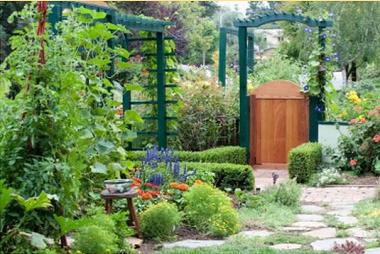
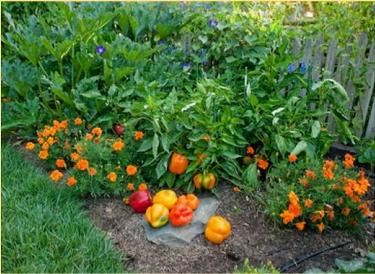
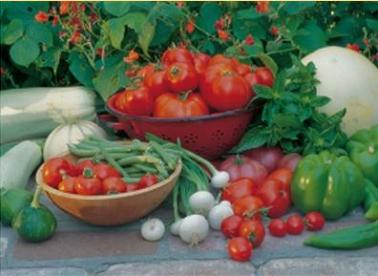
Saving Water
Before we discuss edibles, let's look at other ways you can save water. In your house, if you have not already done so, install efficient toilets, washing machines and showerheads. Take shorter showers and avoid pre-rinsing dishes for the dishwasher. I keep a few plastic gallon buckets (available from paint and hardware stores) near my kitchen and bathroom sinks. When I'm running the hot water and waiting for it to get hot, I catch the cool water in the buckets and use it to water my containers of edibles, etc. For more ways to save water around your home, go to the websites for the Santa Clara Valley Water District www.valleywater.org and the Environmental Protection Agency www.epa.gov/.
Saving water in the landscape
Californians use more than half their household's water on landscaping-mostly the lawn-so that's where you can make the biggest water savings. Cut down on your lawn's size or eliminate it all together, that's the best. In fact, many water districts give a rebate for taking out part or all of your lawn. For hundreds of inspired ideas and how-tos for your reimagined lawn, enter "lawn alternatives, images" in your web browser.
Beyond shrinking or eliminating the lawn, here are many ways to cut down on water use in the garden, including:
Incorporate organic matter in your soil - A 3-inch layer of compost turned into your soil to a depth of 6 inches (about a shovel blade depth) can increase the water holding capacity of the soil by two and a half times. Soils augmented this way can provide plants with water for up to a week between waterings. The Rodale Institute has a simple equation: 1 pound of carbon (aka compost) = 40 pounds of water retention.
Mulch heavily - Use garden compost, pine needles, aged sawdust, fall leaves, and/or straw to mulch. For annual flowers and vegetables make sure that your compost is well aged; otherwise the soil microbes will rob the soil of needed nitrogen as they break down the organic matter.
The looser the material, the more you need to watch for slugs and snails that can hide in the mulch. Keep the mulch 6 inches away from the crown of annuals, perennials, shrubs and tree trunks to prevent diseases.
.
Before we discuss edibles, let's look at other ways you can save water. In your house, if you have not already done so, install efficient toilets, washing machines and showerheads. Take shorter showers and avoid pre-rinsing dishes for the dishwasher. I keep a few plastic gallon buckets (available from paint and hardware stores) near my kitchen and bathroom sinks. When I'm running the hot water and waiting for it to get hot, I catch the cool water in the buckets and use it to water my containers of edibles, etc. For more ways to save water around your home, go to the websites for the Santa Clara Valley Water District www.valleywater.org and the Environmental Protection Agency www.epa.gov/.
Saving water in the landscape
Californians use more than half their household's water on landscaping-mostly the lawn-so that's where you can make the biggest water savings. Cut down on your lawn's size or eliminate it all together, that's the best. In fact, many water districts give a rebate for taking out part or all of your lawn. For hundreds of inspired ideas and how-tos for your reimagined lawn, enter "lawn alternatives, images" in your web browser.
Beyond shrinking or eliminating the lawn, here are many ways to cut down on water use in the garden, including:
Incorporate organic matter in your soil - A 3-inch layer of compost turned into your soil to a depth of 6 inches (about a shovel blade depth) can increase the water holding capacity of the soil by two and a half times. Soils augmented this way can provide plants with water for up to a week between waterings. The Rodale Institute has a simple equation: 1 pound of carbon (aka compost) = 40 pounds of water retention.
Mulch heavily - Use garden compost, pine needles, aged sawdust, fall leaves, and/or straw to mulch. For annual flowers and vegetables make sure that your compost is well aged; otherwise the soil microbes will rob the soil of needed nitrogen as they break down the organic matter.
The looser the material, the more you need to watch for slugs and snails that can hide in the mulch. Keep the mulch 6 inches away from the crown of annuals, perennials, shrubs and tree trunks to prevent diseases.
.
Water deeply and infrequently - A great tool to make sure your plants are watered properly is a soil probe. Push the probe into the soil as far as you can - 6 to 12 inches or more. Remove it and look at the sample and see if it contains damp or dry soil. When soil gets very dry, it becomes hydrophobic and actually sheds water just like a dry sponge. It's important to apply the water slowly and let it be absorbed or else most of your water will drain away. You can find lots of images online to help you identify hydrophobic soil. If you don't want to invest in a soil probe, just use a shovel and open and inspect a slice of soil 6 to 8 inches down.
Surface roots dry out faster than those at least 6 inches deep. If you have spray heads, set your irrigation timer for shorter periods and water again a few hours later. This allows water to penetrate more deeply into the soil. Most irrigation timers can be set to do this.
Deep-root watering large shrubs and trees is much more efficient than most irrigation techniques as it distributes water a foot or more below the surface. Done properly a few times a summer it eliminates surface run off and reduces erosion and evaporation. I run water into an old plastic pail but you can use a rusty bucket or even milk jugs with a few 1⁄2-inch holes in the bottom. Move the containers to the drip line, fill with water and let the water slowly leak into the soil. When empty, move the container(s) to another quadrant. You can have an irrigation specialist install your system, or for DIY go to your local plumbing supply store. Most will give you help and sell drip parts.
There's plenty of info online for installing drip, watering schedules, and lots of equipment options: The Urban Farmer Store in San Francisco www.urbanfarmerstore.com/, Harmony Farm Supply in Sebastopol, CA www.harmonyfarm.com/ and Peaceful Valley Farm Supply in Grass Valley, CA www.groworganic.com/.
Install a drip system - Use drip irrigation for shrub borders, fruit trees, flowerbeds and vegetable gardens. It's dramatically more efficient than overhead sprinklers; some experts say as much as 50%. Plus, it cuts down on weeds, water runoff, and fungal diseases.
That said, a well-thought-out system saves many headaches. However, in all honesty, drip does take effort to install and attention to keep it running well.
Tips For Success with Drip Irrigation:
1. Avoid cheap irrigation "kits" available from discount stores and online sources.
It's hard to find parts to repair these systems. In some cases, the cheap plastic expands in hot weather and pops off.
2. I recommend professional grade in-line emitters that drip water from holes in
the line rather than a solid tubing system with installed emitters.
3. Choose "shrubblers" and micro-sprayers for annuals in containers; look for flow
control so you can adjust the water pattern for changing individual plants.
4. Install a good filter and change it every few months.
5. Cover the tubing with mulch-not only because it looks better-it protects the
plastic from ultraviolet light so it lasts longer.
6. Run the system every few weeks to look and see that there are no leaks or clogs.
Surface roots dry out faster than those at least 6 inches deep. If you have spray heads, set your irrigation timer for shorter periods and water again a few hours later. This allows water to penetrate more deeply into the soil. Most irrigation timers can be set to do this.
Deep-root watering large shrubs and trees is much more efficient than most irrigation techniques as it distributes water a foot or more below the surface. Done properly a few times a summer it eliminates surface run off and reduces erosion and evaporation. I run water into an old plastic pail but you can use a rusty bucket or even milk jugs with a few 1⁄2-inch holes in the bottom. Move the containers to the drip line, fill with water and let the water slowly leak into the soil. When empty, move the container(s) to another quadrant. You can have an irrigation specialist install your system, or for DIY go to your local plumbing supply store. Most will give you help and sell drip parts.
There's plenty of info online for installing drip, watering schedules, and lots of equipment options: The Urban Farmer Store in San Francisco www.urbanfarmerstore.com/, Harmony Farm Supply in Sebastopol, CA www.harmonyfarm.com/ and Peaceful Valley Farm Supply in Grass Valley, CA www.groworganic.com/.
Install a drip system - Use drip irrigation for shrub borders, fruit trees, flowerbeds and vegetable gardens. It's dramatically more efficient than overhead sprinklers; some experts say as much as 50%. Plus, it cuts down on weeds, water runoff, and fungal diseases.
That said, a well-thought-out system saves many headaches. However, in all honesty, drip does take effort to install and attention to keep it running well.
Tips For Success with Drip Irrigation:
1. Avoid cheap irrigation "kits" available from discount stores and online sources.
It's hard to find parts to repair these systems. In some cases, the cheap plastic expands in hot weather and pops off.
2. I recommend professional grade in-line emitters that drip water from holes in
the line rather than a solid tubing system with installed emitters.
3. Choose "shrubblers" and micro-sprayers for annuals in containers; look for flow
control so you can adjust the water pattern for changing individual plants.
4. Install a good filter and change it every few months.
5. Cover the tubing with mulch-not only because it looks better-it protects the
plastic from ultraviolet light so it lasts longer.
6. Run the system every few weeks to look and see that there are no leaks or clogs.
Use grey water when possible - Grey water is defined as relatively clean wastewater from showers, baths, sinks, and washing machines. Grey water is suitable for use in the garden as soil microbes tie up most disease organisms and toxins. Care must be used when watering edible plants, however, it's fine to use grey water on fruit trees, as there is no risk of getting water on the fruit.
I only use clean potable water on leafy greens, strawberries and other low plants and wash all produce well in clean water. Avoid laundry soaps that contain sodium, salt compounds and boron, which can damage plants. Look for products such as Dr. Bronner's soaps for the kitchen and bathroom and Oasis for your laundry. For much more information on grey water and soap brands consult www.greywateraction.org/.
Install rain barrels - Why have rain barrels when we are getting so little rain? I use two 75-gallon barrels all year long to store grey water to water my plants. For a diagram and guidelines on how to best use rainwater see the city of Berkeley's website www.ci.berkeley.ca.us/ (under Rain Water Harvesting) for information; and Gardeners Supply www.gardeners.com/ and the Urban Farmer Store for rain barrels and how to set them up.
Growing Edibles in your garden
For more basic information on how to grow edibles consult the following websites: my website www.rosalindcreasy.com/, Renee's Garden Seeds www.reneesgarden.com/, Mother Earth News www.motherearthnews.com/, Sunset Publishing www.sunset.com and the website for Common Ground. For edible plant seeds and transplants, visit your local nursery. Nowadays, your local nurseries carry dozens of different varieties and most can direct you to ones that grow best in your area.
.
I only use clean potable water on leafy greens, strawberries and other low plants and wash all produce well in clean water. Avoid laundry soaps that contain sodium, salt compounds and boron, which can damage plants. Look for products such as Dr. Bronner's soaps for the kitchen and bathroom and Oasis for your laundry. For much more information on grey water and soap brands consult www.greywateraction.org/.
Install rain barrels - Why have rain barrels when we are getting so little rain? I use two 75-gallon barrels all year long to store grey water to water my plants. For a diagram and guidelines on how to best use rainwater see the city of Berkeley's website www.ci.berkeley.ca.us/ (under Rain Water Harvesting) for information; and Gardeners Supply www.gardeners.com/ and the Urban Farmer Store for rain barrels and how to set them up.
Growing Edibles in your garden
For more basic information on how to grow edibles consult the following websites: my website www.rosalindcreasy.com/, Renee's Garden Seeds www.reneesgarden.com/, Mother Earth News www.motherearthnews.com/, Sunset Publishing www.sunset.com and the website for Common Ground. For edible plant seeds and transplants, visit your local nursery. Nowadays, your local nurseries carry dozens of different varieties and most can direct you to ones that grow best in your area.
.
All my favorite culinary herbs can be grown in a few recycled wine barrels. Notice that there's a smaller one nested on top of a large barrel. Here Thai basil, chives, savory, tarragon, sage, French sorrel, and thyme are grouped together and watered by drip irrigation on an automatic timer that comes on twice a day for 5 minutes all summer. A bonus container of strawberries is on the same system.
Download a printable copy of this article
Download a printable copy of this article
